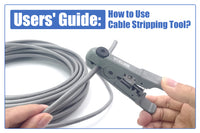Wire cutters are indispensable hand tools for a diverse range of individuals, including electricians, homeowners, DIY hobbyists, and professional installers. These versatile tools play a crucial role in cutting various materials that require precise material cutting. Different from conventional cutting tools, wire cutters usually feature different designs for specialized uses. We’ll delve into everything about wire cutters in this article, aiming to provide an informative guide for your diverse needs.
What is Wire Cutter?
Wire cutters, or diagonal pliers, stand as indispensable hand tools applied in low-voltage projects such as electrical tasks and network installations. They are mainly used to cut various wires but can also be used to cut materials like plastic and thin metal. The wire cutter is composed of two parts: the short part is called the jaw and the longer part is known as the handle. Wire cutters are usually made of hard steel and feature sharp cutting edges.

Different wire cutters have different jaw shapes. More than one type of wire cutter in your toolbox is required, and the topic will be further explored in the forthcoming content.
Wire Cutter Types
Wire cutters can be classified into various types based on specified applications. For example, the jaw can be tapered or oval. The oval jaw is the standard jaw shape combining strong strength and good durability, and it is often used to cut solid and thick wires; the tapered jaw features less metal in the head and can be used in limited areas. Here are some several commonly used wire cutters.
Side Cutter
A side cutter is used to cut and strip wires and cables. The offset cutting edge is designed to make a clean and smooth cut. Side cutters can be used to cut various materials, including thin metal, zip ties, plastic, and soft wires, but it should be noted they are not suitable for cutting hard materials. Side cutters come in various sizes and designs, allowing you to choose based on your needs. To ensure long-term use of a side cutter, you’d better choose those with hard steel blades.
Some people call side cutters diagonal cutters, but it’s worth noting that there are some slight differences between them. The diagonal cutter is often applied in delicate cutting tasks, while the side cutter can be used in larger tasks.
Cable Cutter
Cable cutters are designed to cut various cables, especially electrical cables. The handle of the cable cutter is often insulated to avoid electrical shocks. This cutter features a sharp blade to cleanly cut cables without destroying the cable construction. A high-quality cable cutter features a stiff steel blade and a comfortable handle for easy use.
Some cable cutters on the market feature a long handle to cut thick cables easily, and some also feature a ratcheting mechanism, allowing users to make multiple cuts with minimal effort.
If you often work with electrical tasks, you may not only need a cable cutter but also a cable stripper and crimper. At this time, an all-in-one cable cutter is your prior choice.
Flush Cutter
A flush cutter, also referred to as a flush cutting plier, is a cutting tool with angled jaws that allows for a precise cut. Flush cutters are designed to make a flush cut close to the material’s surface.
This cutter is ideal for daily use and suitable for circuit board work, jewelry making, and electrical work. Some flush cutters also feature a built-in spring-loaded mechanism, making it easy to open and use the cutter.
End Cutter
The end cutter has a unique jaw shape, and the cutting edges are located at the tip of the jaws, allowing users to get close to the materials to cut. The cutting edges are parallel to each other for straight and smooth flush cutting.
End cutters are commonly used to cut hard wires, cut and pull nails, and make jewelry. This tool is especially suitable for repetitive hard wire cutting to save labor.
How to Choose Wire Cutter?
Wire cutters play an important role in fields like electrical work, telecommunication, cable management, home improvement, network installation, jewelry making, and other DIY projects. Here are some factors you should consider when choosing a good wire cutter.
-
Blade Material: The blade material can largely determines what materials can be cut and the cutter’s service life. Many wire cutters on the market are only designed for soft wires, which may cause damage when used on tougher materials. Look for blades crafted from robust steel with a high HRC value to ensure durability. Also, match the cutter’s type and gauge to the materials you’ll be working with.
-
Size & Weight: Wire cutters are available in a range of sizes and weights, allowing you to select one according to your needs. For example, a compact yet functional wire cutter is preferable in your tool bag over a heavy-duty alternative.
-
Cutting Capacity: It is known that different wires have different gauges. The cutting capacity of the wire cutter informs you of what size and gauge wires can be cut. Always check the cutting capacity of the wire cutter before making a purchase.
-
Handle Length & Material: The handle length is related to leverage. The longer the handle, the greater the cutting force and leverage. A wire cutter with a long handle allows you to cut off hard wires with less strength. Moreover, the ergonomic handle also benefits you when using the wire cutter, enabling you to cut wires easily and comfortably.
The handle length directly impacts leverage, influencing cutting force. Opt for a wire cutter with an appropriate handle length; longer handles provide increased cutting force and leverage. Additionally, prioritize ergonomic handles for comfortable and efficient use, especially when dealing with challenging wires that require more strength.
- Cost: The cost of a wire cutter varies according to brands, materials, and functions. Just buy the best tools you can afford.
Wire Cutter Maintenance and Using Tips
To optimize the performance and extend the longevity of your wire cutter, regular maintenance is paramount. Consider the following guidelines for maintaining and utilizing your wire cutter effectively:
- Clean the blade and remove the debris every time you use the wire cutter to ensure optimal cutting efficiency.
- Regularly apply oil to the hinge for smooth operation.
- If the blade becomes dull over time, rejuvenate its sharpness by skillfully sharpening it with a whetstone.
- Don’t use your wire cutter to cut tough materials unless it is specifically designed for such applications.
- Protective eyewear is recommended when you use a wire cutter.
- Opt for the wire cutter with insulated handles when engaging in electrical work to mitigate the risk of electrical shock.
- Avoid exposing your wire cutter in high temperatures to prevent potential damage.
- Cut objects at a right angle for easy use.
- Always remember to follow the manufacturer’s instructions to ensure safe and effective usage.
For more information on this topic, you can keep up on our blogs. While VCELINK offers general and basic information for our customers and other visitors to the website, it’s not professional advice.






Be the first one to comment.
Leave a comment